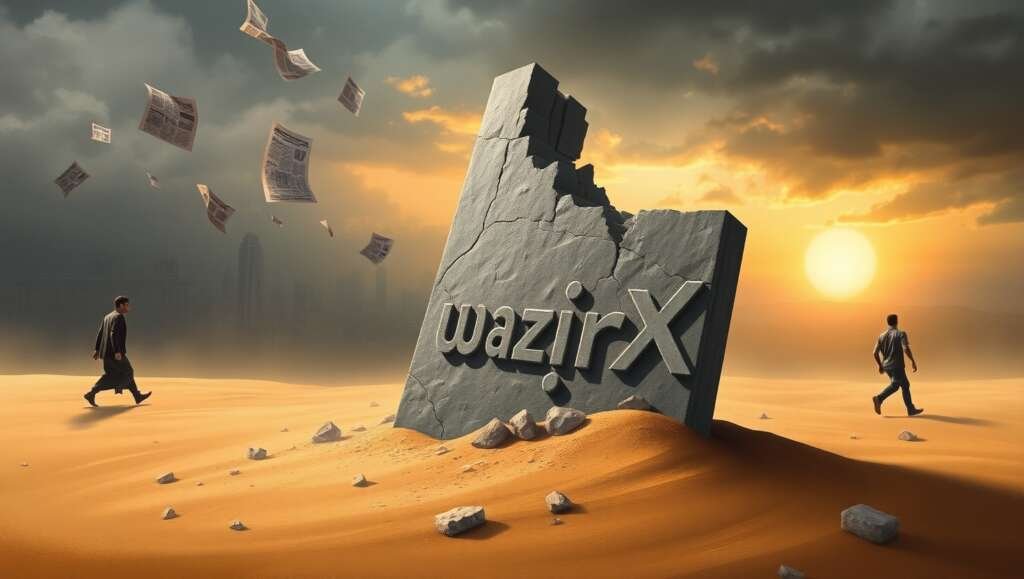If you’ve been in or around the Indian crypto scene, especially over the past few weeks, you have surely felt the tremors! WazirX, previously the shining star in crypto, has now gone through a perfect storm- a public spat with a global giant, regulatory scrutiny, and massive trust loss with its user base. For many of those who bought their first Satoshi on the platform, it was bewildering and concerning.
This is not just a tale of a company in difficulty. It’s a tale of the coming of age of an entire industry. This is about the consequences of innovation outpacing regulation and the real dangers we all confront as investors in the new digital wild west. Let us shed some light and outline what took place, why it’s important, and future possibilities.
The Fall of the High-Roller
For quite some time, WazirX was not simply a participant in the Indian crypto market—it was the market. For many, it served as the nearby, friendly on-ramp for both new and seasoned investors wanting exposure to Bitcoin, Ethereum, and the countless other digital assets available. With a simplified user interface and bright innovations like P2P trading, it became a household name.
But that reputation was lost in a very public and spectacular manner.
Dubbed “the fiasco,” it wasn’t a singular incident. Rather, it was an entire ongoing series of unbelievable events:
- A public fight over who owned the company.
- A significant investigation by India’s financial crime-fighting agency.
- An ensuing rush by users to get their funds out.
This is a very significant occurrence, both for WazirX customers and for every single person interested in crypto in India. It provides a gigantic and very real-time frame for how the government might attempt to regulate this industry—and more importantly, a very real lesson for all of us in what we think about when we store our digital wealth.
What is WazirX?
To comprehend the fall, we first must appreciate the ascent.
Founded in 2018 by Nischal Shetty, Sameer Mhatre, and Siddharth Menon, WazirX entered a market when crypto was still an outlier interest in India and often viewed with skepticism by the traditional finance world.
Their vision was simple yet powerful: make crypto available for every Indian.
The P2P Genius Move
In 2019, WazirX launched its automated Peer-to-Peer (P2P) system—a stroke of genius.
Why? Because it solved a big problem: banking barriers.
When banks began blocking or delaying transactions directly to crypto exchanges, WazirX allowed users to trade directly with each other, with WazirX acting as escrow. This saved the day for the entire Indian crypto community.
The Binance Validation
WazirX’s popularity skyrocketed as they launched their own native token, WRX, while sponsoring popular shows and rolling out educational content. Its credibility received a significant boost when Binance, in late 2019, announced that it acquired WazirX.
It felt like ultimate validation—the local hero chosen by the global champion. The future looked limitless.
How the WazirX Fiasco Unfolded
The unraveling was slow, then suddenly very fast. Here’s how it played out in key moments.
1. The Acquisition
The entire saga hinges on a single question: Who actually owned WazirX? Since November 2019, everyone, including the users, media, and even the industry, operated on the fact that Binance had acquired WazirX. It was listed on Binance’s website, and the platforms were deeply integrated. WazirX handled INR (Indian Rupee) deposits, and you could seamlessly transfer crypto to Binance for more advanced trading.
The first crack appeared in February 2022. The Indian authorities were working on a new tax regime for crypto, while the Enforcement Directorate (ED) was already investigating some exchanges. Binance CEO Changpeng Zhao (CZ) caused a frenzy in a now-infamous Twitter thread on February 4, 2022, when replying to a user with the words, “Binance does not have any equity stake in Zanmai Labs, the entity operating WazirX.”
Quick thread on Binance and WazirX, and some incorrect reporting.
Binance does not own any equity in Zanmai Labs, the entity operating WazirX and established by the original founders.
1/4
— CZ 🔶 BNB (@cz_binance) August 5, 2022
That was stunning. Nischal Shetty immediately countered by clarifying that while Binance owned WazirX’s domain and certain crypto assets, Zanmai Labs was an India-based licensed entity by which Binance covered the INR-crypto trading part of the exchange. This incident left the community entirely bewildered and on edge, as two of the most significant and prominent figures in the crypto space were openly having a back-and-forth. If Binance truly had decided to distance itself from WazirX, this could somehow affect the stability of the exchange.
2. The Crisis
The uncertainty related to ownership evolved into a complete catastrophe in August 2022. On August 5, the Enforcement Directorate (ED)—India’s foremost agency for tackling financial crime announced that it had ordered the freezing of WazirX’s bank assets valued at ₹64.67 crores (more than $8 million USD).
The implications were severe. The ED had turned its attention to a number of Chinese-owned illegal online betting applications, allegedly laundering money from the traditional economy into the crypto ecosystem. The allegation was that WazirX’s KYC (Know Your Customer) protocols were either inadequate, non-existent, or easily circumvented. The ED alleged that WazirX knowingly allowed individuals to convert illicit proceeds into crypto without any checks for authenticity or legitimacy, for the purpose of enabling money laundering.
The ED’s declaration was damning: “WazirX does not take the requisite documents from its clients, which makes it impossible to determine the origin of the funds.” This was a direct attack on the very foundation of any financial exchange’s legitimacy.
3. User Panic and Platform Instability
The news of the ED’s freeze was a red alert for users. A sudden flurry of panic selling and withdrawal requests engulfed the platform. Social media, Twitter especially, was rife with anxious users reporting delayed withdrawal, failed transfers, and unresponsive support. The anxiety was real: “Is my money stuck?” “Is WazirX going down?”
Although the exchange did not completely shut down, the stress on its platform, added to the fall in trust, was catastrophic. Trading volume and revenue that once made WazirX the top exchange in the country fell sharply as users fled to other exchanges or withdrew their funds to private wallets. The Binance-WazirX feud reignited instantly after the ED’s action. CZ from Binance publicly stated that the issues lay with the “off-chain fund transfer partners” that WazirX used for INR transactions—essentially pointing the finger back at Zanmai Labs’s operations. He revealed that Binance was withdrawing the ability to off-ramp funds from its platform to WazirX. Nischal Shetty and the team at WazirX insisted that they were compliant and cooperating with the investigation in a relentless back-and-forth in public for millions of users to view. The back-and-forth did not ease nerves and contributed to confusion and a lack of accountability.
People playing deception wording games. We can shut down the domain. It just hurts users. We do NOT have control of the trading system. You just gave the AWS login, no source code, no deployment capability. You also retained access to the AWS account, source code, deploy, etc. https://t.co/Zpp6MYlHtp
— CZ 🔶 BNB (@cz_binance) August 6, 2022
The Main Issues Underlying the Controversy
When peeled back, three main issues were at the center of all of this mess:
1. The regulatory uncertainty of crypto in India has been ambiguous. In 2020, the Supreme Court of India lifted an “illegal” banking ban on crypto; however, the new Indian government had yet to enact comprehensive legislation. Honest crypto exchanges operated in a grey area, seeking to self-regulate. The case of WazirX illustrates the potential unintended ramifications of a regulator’s ambiguous posture. It is easy for a government regulator to accuse a crypto exchange of regulatory infringement in the absence of specific policy direction.
2. Know Your Customer (KYC) and Anti-Money Laundering (AML) obligations are the foundation of every legitimate financial service. The grave implication that these were comparatively weak, which WazirX never previously disputed, now damages the legitimacy of WazirX and allows it, whether designed or otherwise, to be exploited and illegitimately used.
3. The Binance Question: A ‘Cloak of Liability?’ Binance’s effort to distance itself from WazirX raised big issues about liability and responsibility in the decentralized world of crypto. If a global powerhouse, primarily a money transmitter in the crypto category, can purchase the local platform, create deep embeddedness in the ecosystem, and then disavow ownership when things get difficult, what does that mean for consumer protection? It set a dangerous precedent and abandoned users.
The Impact on Users and the Indian Crypto Market
The ripple effects were immediate and widespread:
Loss of Confidence: The most significant damage was to trust. WazirX’s brand, built over the years, was severely tarnished overnight.
Financial Exodus: Users didn’t just stop trading; they pulled their funds out en masse. Data from analytics firms showed a dramatic drop in WazirX’s trading volumes and active users, with competitors like CoinDCX and ZebPay gaining market share.
Community Anxiety: The event sent a chill through the entire Indian crypto community. It was a wake-up call that even the biggest and most trusted platforms were vulnerable to regulatory action and operational risk.
Setback for Adoption: For newcomers, the negative headlines were a major deterrent. The fiasco likely slowed down the adoption of crypto in India, associating it with risk, scandal, and uncertainty.
Government & Regulatory Response
The ED’s action was the primary response, but it was part of a larger pattern. The Indian government has been increasingly focused on bringing crypto under a regulatory framework to prevent exactly the kind of misuse alleged in the WazirX case.
The 2022 budget introduced a 30% tax on crypto profits and a 1% TDS on all transactions, which, while criticized, was the first step toward formal recognition. The WazirX incident likely hardened the government’s resolve to create stricter KYC and AML mandates for all Virtual Digital Asset (VDA) service providers. The message was clear: operate without robust checks, and face serious consequences.
Binance’s Position: A Changing of Clarity or Rather Confusion?
Binance’s position in this saga has never been simple nor, frankly, clear. Their original announcement about their acquisition was greeted with great celebration. Their subsequent (and seemingly entirely legally justified) separation from the announcement was a public relations nightmare.
Binance likely coded the acquisition to properly negotiate India’s torturous regulatory environment from a legal standpoint. From a user standpoint, however, it was a betrayal. It represented the consequences of complex corporate structures, which are prevalent in the crypto space and can endanger user safety. This entire episode created a somewhat precarious position for Binance in one of its largest potential markets; it described the company/described Binance as an unsafe partner.
Can WazirX Rise Again?
So, what happens now? The path forward for WazirX is incredibly challenging. Is it shutting down? In the immediate term, probably not. The platform continues to operate, but it is a shell of its former self.
Restoring Trust: That’s the big challenge. Trust is the most important currency in finance, and it is very hard to re-establish trust, once it is lost, to take years of perfect service, extreme transparency, total change of management and perhaps total change of ownership.
Ongoing Litigation: The proceeding of the ED case is the first priority. It would indicate that a long litigation is about to take place, which will ultimately determine the fate of WazirX, either it will be left with heavy fines or to its betterment.
Selling or Rebranding? Another option is that the current owners are looking to sell whatever is left of the business or to rebrand the company to shed the negative stigma attached to the name “WazirX”. It should be noted that selling the business would come with significant legal and reputational issues.
Lessons for the Crypto Investor
This whole ordeal is a painful but valuable lesson for every investor. Here’s what we must learn from it:
Extreme Due Diligence: Before using any exchange, research deeply. Who owns it? Where is it incorporated? What is its reputation? Don’t just go for the most popular name.
Embrace “Not Your Keys, Not Your Crypto”: This is the golden rule of crypto. If your assets are on an exchange, you don’t truly control them. Any significant long-term crypto holdings should be held in a self-custody wallet. A hardware wallet (such as Ledger or Trezor) is the gold standard of security.
Diversify your risk: Do not keep all your assets on one exchange. Use multiple exchanges, and, more importantly, get into your own private wallets.
Stay Constantly Informed: The crypto landscape changes on a daily basis. News about regulations, solvency issues, and market trends can change instantly. Make it a habit to stay informed from reliable sources.
A Defining Moment for Indian Crypto
The situation with WazirX is a defining moment in time. It serves as a cautionary tale for the dangers of acting in a regulatory vacuum, the consequences of corporate responsibility, and that individual vigilante has to be non-negotiable.
In relation to India, it highlights the immediate need for regulations that are clear, fair and robust, protecting investors without stifling innovation. For the users, it was a harsh reminder of the fact that in the exciting, frontier world of crypto, responsibility lies ultimately upon us for our risks and investments—not something you can leave to the platform or founder. The future of crypto in India remains bright. Only this time, the participants will be cautious, informed, and secure.




